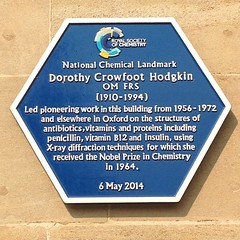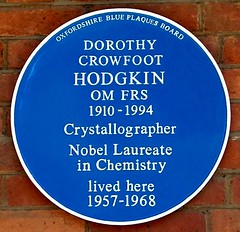Dorothy Hodgkin OM FRS FRIC
Dorothy Hodgkin OM FRS FRIC
(1910-1994)
woman, Fellow of the Royal Society, Dalton Medal recipient, Fellow of the Royal Institute of Chemistry, Nobel Chemistry Laureate (from 1964), and Order of Merit recipient (from 1965)
Commemorated on 5 plaques
Dorothy Hodgkin 1910-1994 biochemist and Nobel Laureate who determined the structure of penicillin and vitamin B12 studied at this school 1921-1928
John Leman Grammar School, Beccles, United Kingdom where they studied
This plaque commemorates a life's work for mankind by Dr Dorothy Hodgkin OM FRS 1910-1994 Nobel Prize Winner 1964 Freeman of Beccles 1965 A former pupil of Sir John Leman Grammar School
John Leman Grammar School, Beccles, United Kingdom where they was
Dorothy Crowfoot Hodgkin OM FRS (1910-1994) led pioneering work in this building from 1956-1972 and elsewhere in Oxford on the structures of antibiotics, vitamins and proteins including penicillin, vitamin B12 and insulin, using X-ray diffraction techniques for which she received the Nobel Prize in Chemistry in 1964.
University of Oxford Inorganic Chemistry Laboratory, Oxford, United Kingdom where they was
The work of Dorothy Crowfoot Hodgkin at the University of Oxford. In this building from 1956-1972 and at other times elsewhere in the Oxford Science Area, Professor Dorothy Crowfoot Hodgkin (1910-1994) OM FRS Nobel Laueate led pioneering work on the structure of antibiotics, vitamins and proteins, including pencillin, vitamin B12 and insulin, using X-ray diffraction techniques. Many methods for solving crystal structure were developed taking advantage of digital computers from the earliest days. The work provided a basis for much of present day molecular structure driven molecular biology and medicinal chemistry
Dyson Perrins Laboratory, University of Oxford, Oxford, United Kingdom where they was (1956-1972)
Dorothy Crowfoot Hodgkin OM FRS 1910-1994 Crystallographer Nobel Laureate in Chemistry lived here 1957-1968
94 Woodstock Road, Oxford, United Kingdom where they lived





